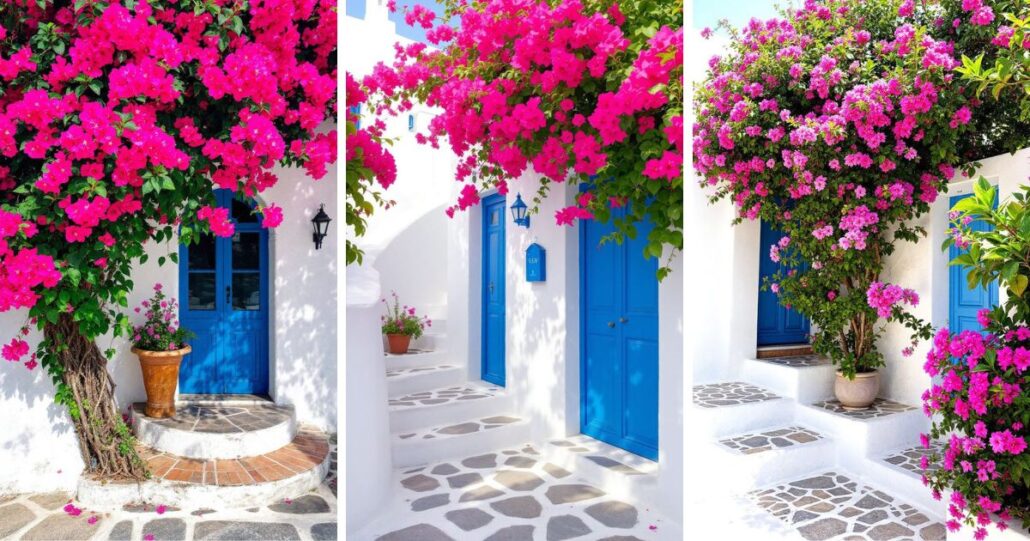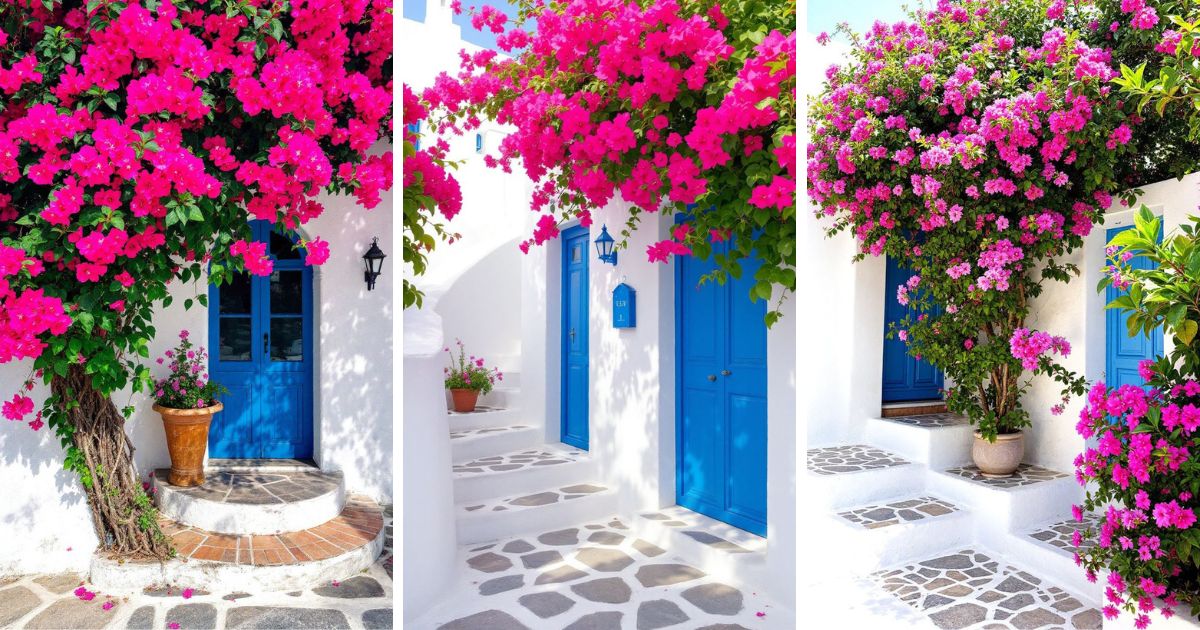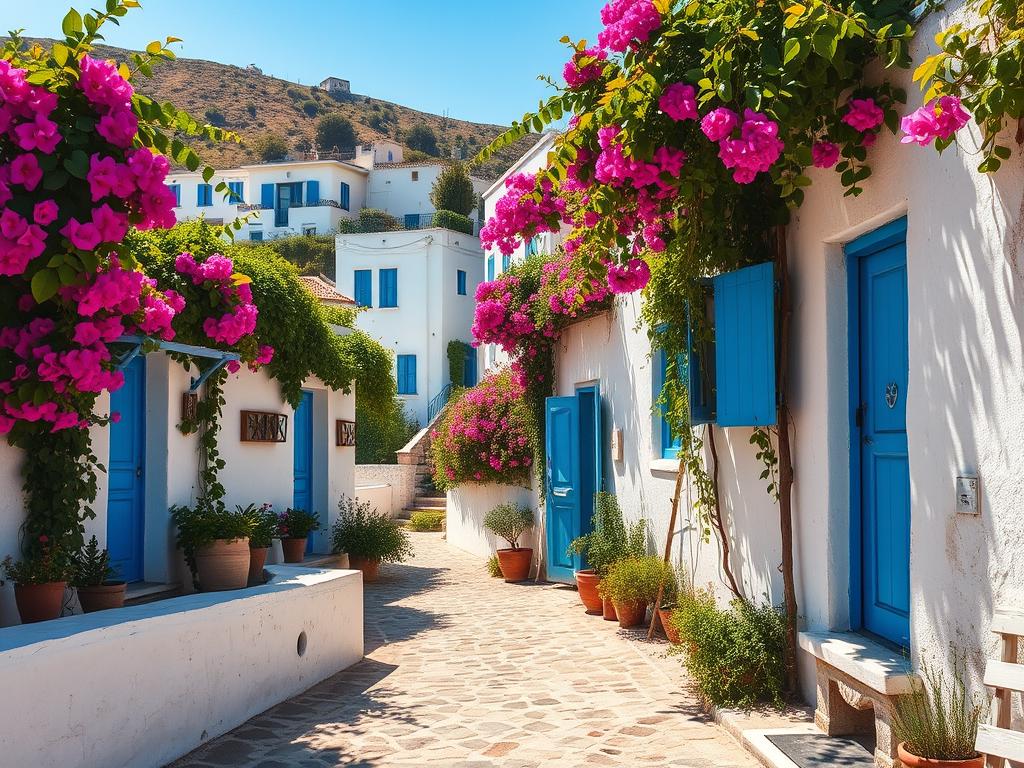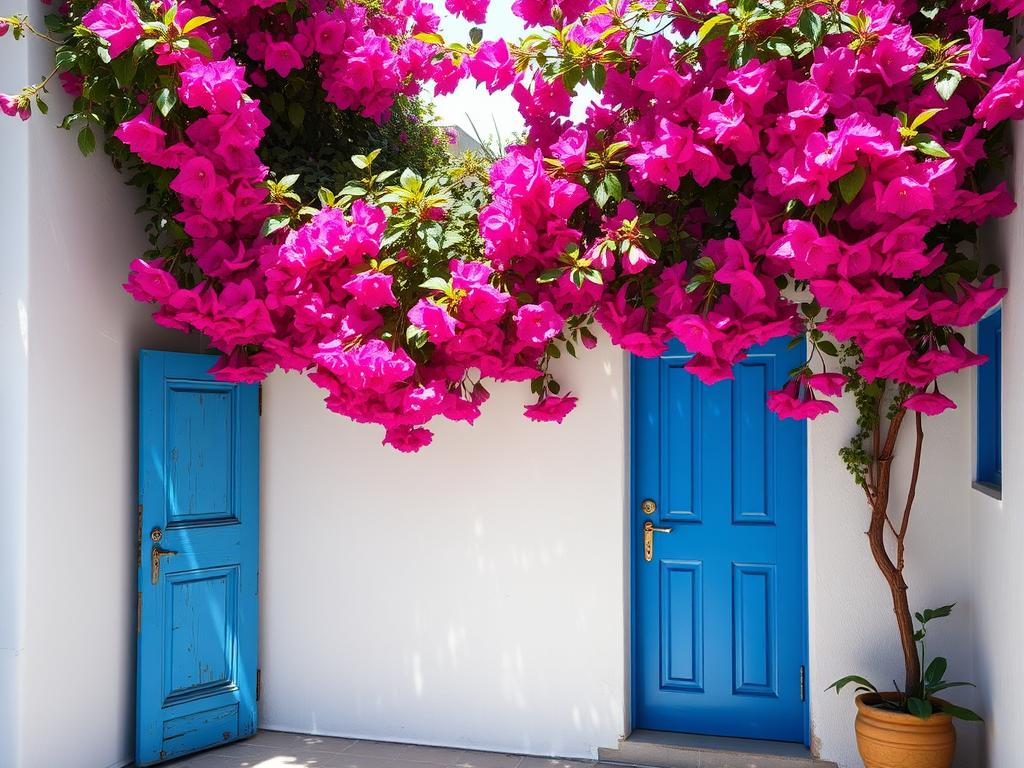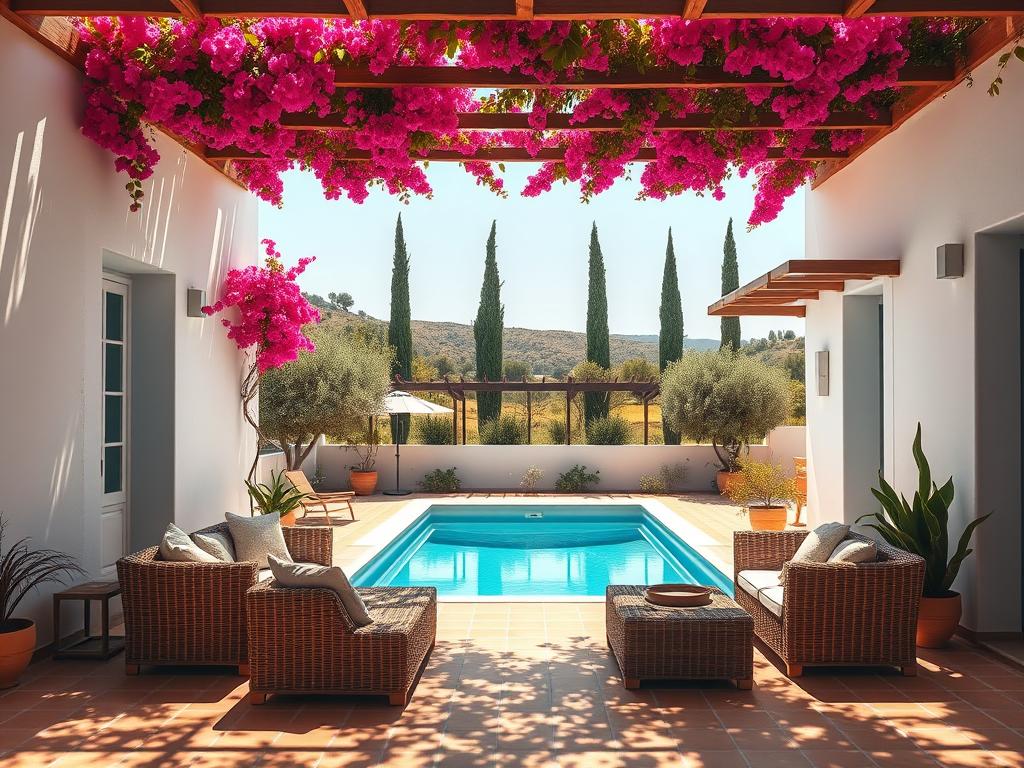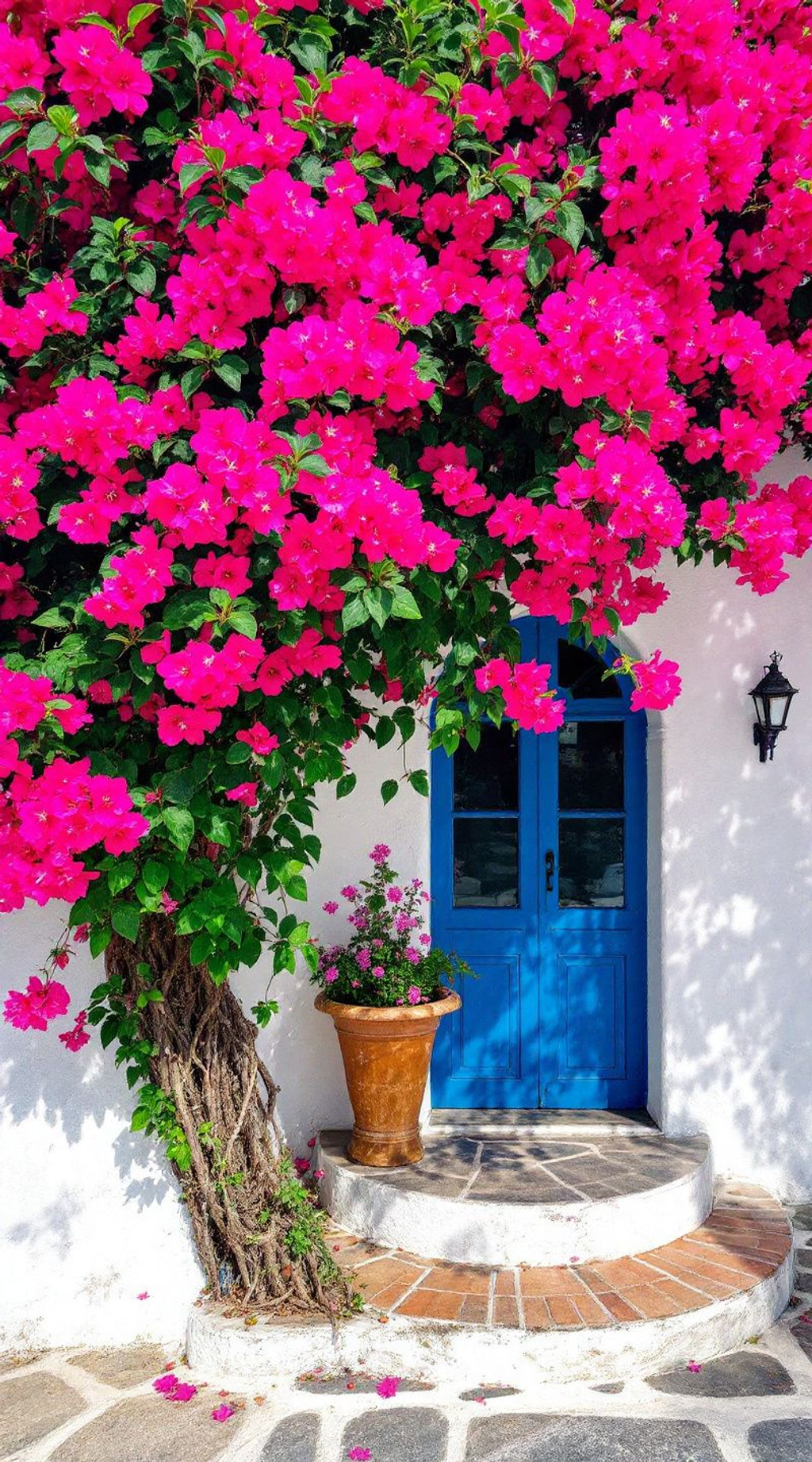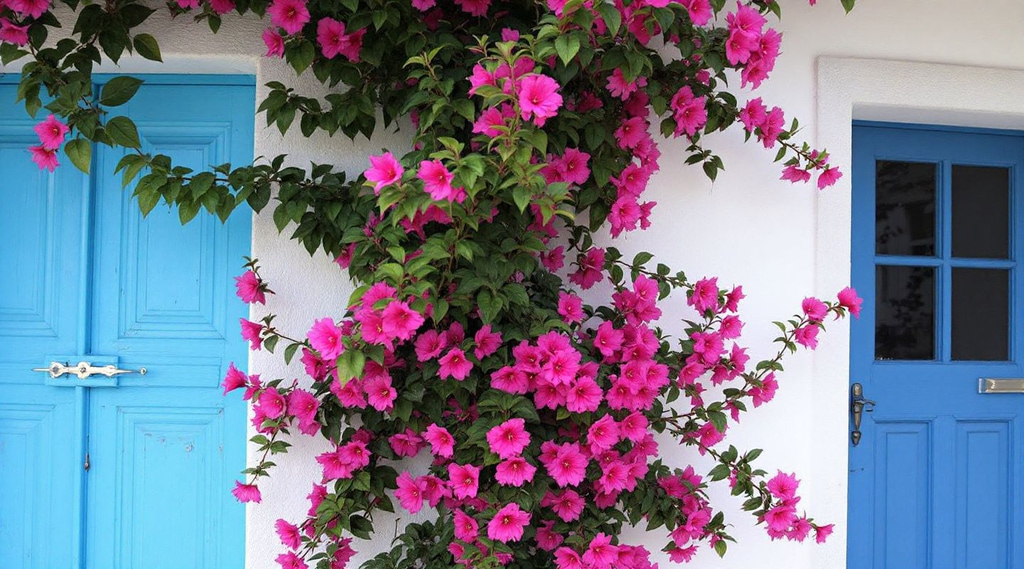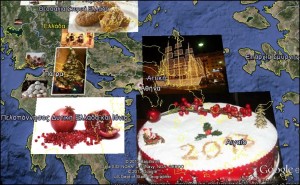Blue Doors and Bougainvillea: Greek Aesthetic Explained
Why do Greek villages glow with cobalt-blue doors framed by bursts of fuchsia bougainvillea, yet their true meaning stays a secret to many?
Step into the sun-drenched world of Greece’s visual identity. The clash of vivid blue doors and fiery bougainvillea isn’t just decoration—it’s history in color. From Santorini’s whitewashed cliffs to Mykonos’ flower-draped courtyards, this iconic mix of blue doors and bougainvillea has become a global symbol of Mediterranean charm. But what turned practical choices into timeless art?
Key Takeaways
- Blue doors and bougainvillea hold hidden cultural and environmental roots.
- Greece’s color traditions adapt ancient practices to modern design.
- Bougainvillea’s bright hues combat harsh climates while beautifying homes.
- These elements create a style copied worldwide but rooted in local needs.
- Understanding their origins reveals why this aesthetic feels both familiar and mysterious.
The Origins of Greece’s Iconic Color Palette
Greece’s timeless look comes from a mix of practicality and beauty. The use of vibrant colors and architectural details started as a way to solve environmental problems. It grew into symbols of national pride.
The Historical Evolution of Greece’s White and Blue Theme
Early Greek buildings used whitewashed lime plaster to fight off the sun’s glare. By the 19th century, white and blue became symbols of Greek identity. Royal decrees and tourism helped make these colors famous. Now, they remind us of harmony with nature and history.
Island Influences on Greek Architectural Identity
Every island had its own architectural details. Santorini’s blue domes stand out against Cycladic white. Crete’s buildings, made from local clay, show a different side of Greek style. These differences make up a unique yet unified national style.
How Climate Shaped Traditional Greek Design
- White walls reflect sunlight, keeping interiors cool.
- Blue accents mirror the Aegean Sea, making spaces more comfortable.
- Stone foundations and narrow windows help keep heat out.
Every design choice had a purpose. Like cobalt-blue window frames that keep insects away. This shows that Greek design is all about form and function.
Why Greek Doors Are Painted Blue
Walking through Greek villages, every blue door has a story. Centuries ago, these colors had practical uses. The paint, made from limestone and plants, kept bugs away.
Today, blue doors and bougainvillea symbolize strength and tradition. People believed blue doors kept evil spirits away—a belief that lives on.
“Painting doors blue wasn’t just about looks—it was our armor against summer bugs and bad luck.”
—Maria, a homeowner in Oia, Santorini
- Protection: Early paints repelled insects and salt corrosion from the sea.
- Spiritual shield: Blue-eyed goddess Athena’s symbolism warded off the “evil eye.”
- National pride: After Greece’s 1821 independence, blue became a unifying color.
Each island has its own blue shade. Cycladic islands have deep ultramarine, while Peloponnese villages prefer sky blues. Today, these colorful home decor traditions inspire designs worldwide. Homeowners in the US mix bougainvillea with bold door colors for a Mediterranean feel.
From practical beginnings to cultural icons, blue doors connect us to Greece’s past. They are as lively in modern gardens as in old whitewashed villages.
Blue Doors and Bougainvillea: A Perfect Mediterranean Pairing
In sunny landscapes, blue doors and bougainvillea come together to show Greece’s mediterranean charm. This pair is more than pretty—it’s a tale of how things work well together.
The Botanical Story of Bougainvillea in Greece
Bougainvillea arrived in Greece in the 1800s from Brazil. It loves the Mediterranean’s heat and dry soil. Now, its vibrant colors match the Aegean Sea’s hues, becoming a part of Greek culture.
How Bougainvillea Enhances Architectural Features
- Color contrast: Fuchsia blooms stand out against blue doors, adding energy.
- Texture play: Bougainvillea’s soft petals contrast with rough stone walls.
- Vertical interest: Vines add movement to buildings.
Experts say this mix of nature and design follows ancient Greek ideas of balance and proportion.
Seasonal Changes and Maintenance of These Vibrant Displays
Gardeners in Greece prune bougainvillea twice a year to help it grow. They protect it from frost in winter so it blooms again in spring. Here’s what locals say:
“Water deeply but rarely—like the sea, it loves salt but hates soggy feet.”
This living art turns simple doorways into stunning works of nature and human skill. It shows that nature’s colors and human creativity can create lasting beauty.
Capturing Greek Aesthetic in Modern Design
Bringing Greek beauty into today’s homes is all about mixing old charm with new needs. Here’s how to make these timeless elements work in your space:
Color Psychology: Blue & Fuchsia’s Emotional Symphony
Blue’s soothing colors remind us of the Aegean Sea. Fuchsia’s vibrant tone is like the blooming bougainvillea. Together, they create a perfect balance. Imagine navy-blue shutters against a soft pink wall. Designers say this mix lifts your mood without feeling too much.
Outdoor Living Spaces: Crafting Mediterranean Vistas
Turn patios into outdoor living spaces with these tips:
- Plant trailing bougainvillea in terracotta pots for instant pictureque scenery.
- Layer textures: whitewashed lattice fences paired with polished marble tiles.
- Add weather-resistant blue accents like umbrellas or railings.
Indoor Inspiration: Bringing the Coast Inside
Bring Greece’s charm indoors without going overboard. Try:
- Azure-and-white accent walls in dining areas
- Fuchsia throw pillows on linen sofas
- Tile patterns mimicking whitewashed stone
Small touches like blue-and-white ceramic vases or fuchsia silk arrangements keep things fresh and modern.
Bringing Mediterranean Charm to American Homes
Transform your home with exterior design inspiration from Greece’s timeless aesthetic. Whether you’re in Arizona’s desert or Seattle’s rain-soaked streets, Greek-inspired details can thrive. Start with crisp white walls paired with navy or Aegean blue accents on doors, shutters, or railings. Add colorful home decor through potted bougainvillea or drought-resistant alternatives like clematis or climbing roses.
Regional adaptations matter. In arid climates, use heat-resistant plants like jade vines or bluebeard shrubs. For colder zones, opt for evergreen climbers or faux floral arrangements. Paint choices are key: Behr’s “Sea Salt” or Sherwin-Williams’ “Saratoga Blue” mimic Greek blues without requiring intense maintenance.
- Arizona: Use light-colored stucco walls to reflect sun, adding terracotta pots with trailing verbena.
- Seattle: Choose moisture-resistant paints and pair blues with ivy or hydrangeas for year-round greenery.
- Urban Townhomes: Frame entryways with blue shutters and hang terracotta planters with trailing flowers.
“Authenticity isn’t about copying—it’s about feeling,” say Mediterranean design experts. Blend elements thoughtfully, like adding a blue door with a zinc roof replica for a modern twist.
Embrace the spirit of Greece without exact replication. Mix bold blues with whitewashed siding, and let trailing blooms soften hard lines. For northern winters, use blue-and-white textiles as temporary colorful home decor. Whether redoing a porch or a patio, small changes can create big impacts. Let the Aegean’s beauty guide your choices, tailored to your backyard’s reality.
Conclusion: The Timeless Appeal of Greek Visual Identity
The mix of blue, white, and bougainvillea is more than a style—it’s a way to talk about a place. For ages, Greek buildings have shown that beauty and use can go hand in hand. The blue door isn’t just a color; it’s a nod to history, weather, and culture.
Bougainvillea’s bright colors aren’t random; they show how to make foreign plants feel at home.
Now, these elements inspire designs for homes all over the world. Picture using Cycladic blue and white in your entrance or adding bougainvillea to your patio. These choices reflect a tradition that values sunlight, stories, and connection to nature.
Greek design teaches us that true beauty lies in simplicity, not in too much. Whether it’s a single blue shutter or a whole courtyard, these traditions see color and shape as a way to connect with our surroundings. When thinking about updating your space, let these timeless ideas guide you. The Mediterranean’s beauty isn’t just for pictures; it’s a living conversation between past and present, ready to inspire your space.

